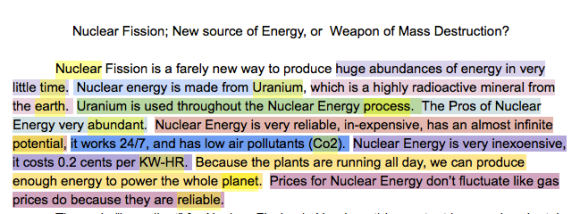I’ve been thinking a great deal about how to measure or index integration of ideas that students have read about from multiple, multi-modal Internet texts. I’ve developed a rubric for my dissertation study. It’s fine. Like any first draft, it could surely be better but for now, it will have to do.
This morning, though, I read a paragraph that a student wrote and I was struck by the incredible density of facts she crammed into one short paragraph. Here it is.
To analyze the origin of each idea, I highlight with a different color and attach a comment to the phrase that includes the information source of the idea. I know where the ideas come from because I have just listened to, transcribed and coded the reading session that preceded this writing. I also have the student’s notes, which I marked up as I listened to the reading session video, with citations and timestamps.
In this slightly reduced version of the paragraph, you can see how I’m using comments to justify my understanding of how students integrate their ideas in their writing.
Okay — so what’s my insight. Well, I’m wondering if an index of integrative density might be a way to infer how well students have integrated ideas across multiple texts. One way to consider how integrated the student’s model of understanding is to look at how many sources informed a single statement. Another would be to consider how many sources informed a single paragraph. To measure this, however, you need to know what the student read. And this, as I have come to know very well, takes a LOT of time to reconstruct.
I wonder, however, if there might be some incredible value to having students reverse trace their reading/writing process? What if, after a student wrote his/her paragraph, teachers asked him/her to articulate, in some way, how he/she came to construct a given sentence — to trace backward the information sources that informed the writing of a sentence or a paragraph?
Do teachers do this already?
Could this help students to think about the ways they construct an integrated account of information they’ve read across multiple texts?
Always more to learn…
]]>

